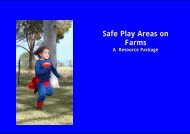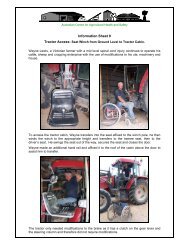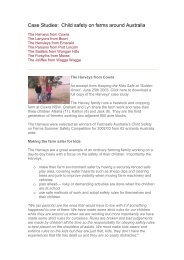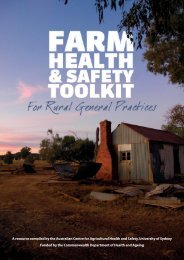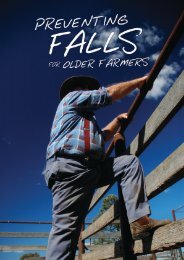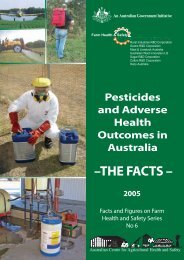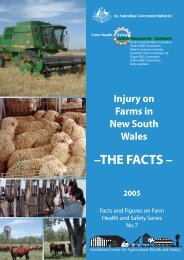Ripper ii Educational resource for primary schools - Australian ...
Ripper ii Educational resource for primary schools - Australian ...
Ripper ii Educational resource for primary schools - Australian ...
You also want an ePaper? Increase the reach of your titles
YUMPU automatically turns print PDFs into web optimized ePapers that Google loves.
FOCUS OF THE RESOURCEThis <strong>resource</strong> aims to provide teachers with a variety of ideas <strong>for</strong> promoting safety on farms within the context of exploring different<strong>Australian</strong> farming environments and production systems. In particular, learning experiences aim to reduce the risk of injury to childrenon farms by increasing awareness and understanding of farm hazards; helping children develop strategies and behaviours to preventinjuries; and by fostering the development of positive attitudes toward safety.Background in<strong>for</strong>mation <strong>for</strong> teachers1. The role of teachersTeachers play an essential role in safety education of children,in partnership with parents and carers. Child safety messagesand processes can be integrated into learning throughout thecurricula, particularly within Health and Physical Education andHumanities (Society and Environment) subject areas, as they arevariously referred to across the states.Key messages delivered through the <strong>for</strong>mal education sectorcompliment those being promoted through the wider farmingcommunity. Teachers can be involved in educating children<strong>for</strong> safety both directly and indirectly (eg. checking theappropriateness of images and text of classroom <strong>resource</strong>s thatsometimes portray children engaging in unsafe practices – suchas riding on tractors). Teaching children strategies to deal withthe major injury risks on farms within their domain of influence,can help to ensure their immediate safety. Teaching children theprocesses involved in making farms safer, is a life skill consistentwith workplace safety requirements and directions.2. Facts about child injury on farms and rural propertiesChildren can have enriching life experiences on farms - yet areexposed to a variety of workplace hazards not accessible to mostchildren. Children are seriously injured on Australia farms andrural properties each year.• There is about one farm- related child death in Australiaevery 3 weeks 1 .• Around eight or more children are admitted to hospitalswith farm related injuries each week 2 .Other hazards/causes of injury on farms include silos, chemicals,noise and firearms. However, injuries from these do not appearprominently in injury statistics.One prominent study 4 of fatalities on farms found that one thirdof child fatalities were visitors to the farm. Boys were killed moreoften than girls (3:1) and three-quarters of children were playing atthe time in an area where farm work was being carried out.Younger children are at greater risk, with two thirds of child fatalitieson farms being under five years of age. Older children 5-15 years arehospitalised or present to emergency departments with non-fatalinjury more than younger children, perhaps reflecting more leisureactivities with horses and motorbikes and their expanding work roles.• Many more children with farm related injuries present atEmergency Departments of country hospitals and toGeneral Practitioners 3 .Key problem areas identified through the research are:• Drowning (0-5 years)• Injury associated with farm machinery• Injury associated with other farm vehicles• Injury associated with 2 and 4 wheeled motorcycles (5-15 years)• Horse-related injury (5-15 years)1. Pollock K , Fragar L, Morton C 2007 Traumatic Deaths in <strong>Australian</strong> Agriculture - The Facts. Rural Industries Research and Development Corporation and <strong>Australian</strong> Centre <strong>for</strong>Agricultural Health and Safety. Moree2. Kreisfeld R 2007 Hospitalised farm injury among children and young people 2000–01 to 2004–05 AIHW NISU Proceedings of the Farmsafe Health and Safety Conference Adelaide Sept 20073. Franklin R and Crosby J 2002 NSW Public Health Bulletin Vol 13 No.5 May 20054. Franklin, R. Mitchell, R. Driscoll, T. Fragar, L. 2000. Farm-related Fatalities in Australia, 1989 - 1992 <strong>Australian</strong> Centre <strong>for</strong> Agricultural Health & Safety, National OccupationalHealth & Safety Commission, & Rural Industries Research & Development Corporation, Moree NSW.






